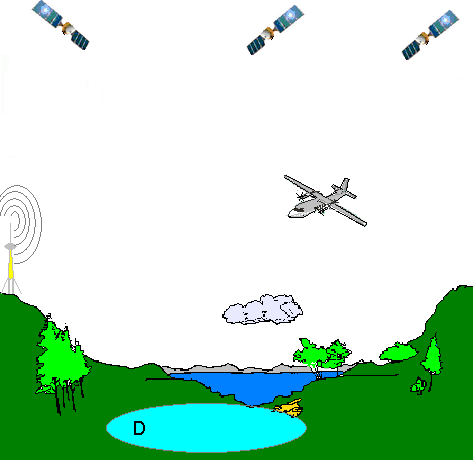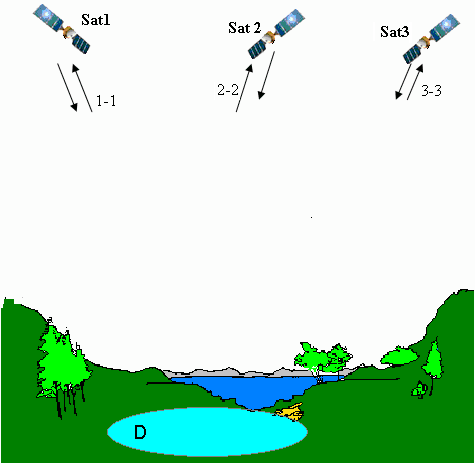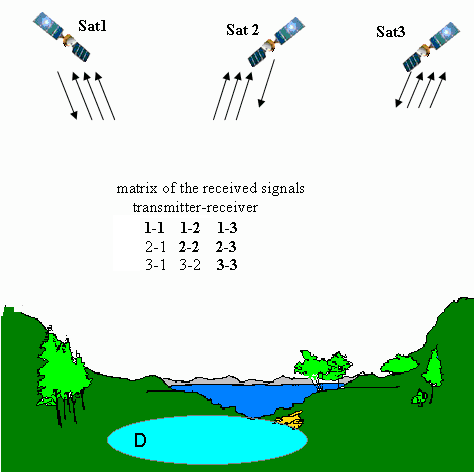|
|
Multiposition Synthetic Aperture Radar (MPSAR) Alexander V Ksendzuk |
| Main Page |
1. Multiposition SAR. Introduction. 1.1. Definition Multiposition Synthetic Aperture Radar (MPSAR) is a set of receivers, transmitters and transceivers (each pair transmitter-receiver is a bistatic pair inside multiposition system) which collects information about objects by mean of remote sensing. The key point of the MPSAR is co-processing of the received processes (in other words input process from each receiver is used for parameter estimation).
Figure 1. In general case multiposition system consists of satellites, aircrafts and stationary receivers/transmitters. All these elements are used for co-processing and parameter estimation of the radar scene D |
||||
| Signal Model | |||||
| Optimal Signal Processing | |||||
| Object detection | |||||
| Multiposition SAR interferometer | |||||
| Pseudonoise signals in remote sensing systems | |||||
| Pseudo-passive SAR | |||||
| Remote sensing systems modeling principles | |||||
| About Author | |||||
| Links | |||||
|
Remote sensing is the science of acquiring information about the objects (celestial body, Earth's surface, different objects such as buildings, vehicles etc.) without actually being in contact with it. This is done by sensing and recording reflected or emitted electromagnetic waves (radio frequency, visual light) with further processing and interpreting. Remote sensing with Synthetic Aperture means coherent collecting of the signal scattered from the surface (usage of the spacecraft motion and signal processing technique to simulate a large antenna). Why multiposition, not multistatic or multisatellite? In some papers similar systems called multistatic SAR or multi-satellite SAR. I prefer to use term multiposition SAR because · the term multistatic sounds like something static or stable in time, the nearest terms monostatic and bistatic appeared when radars were stationary; considered multiposition system dynamic (each element changes spatial position in time); · multi-satellite SAR means system which consists of number of satellites, but multiposition SAR may be, for example single satellite with 2 spatially distributed antennas position (interferometer is the particular case of MPSAR). Hereinafter Multiposition SAR means system with different receiver and transmitter position. Term position means different spatial position, different position in the signal space one aperture transmits signals with different modulation, carrier frequency, polarization etc. Difference between multiposition and multisatellite radar we can explain in one example. Consider three-satellite SAR.
1.2. Classification of the MPSAR Relative spatial configuration: static and variable (distance between different positions are constant or variable in time domain). Information extraction method: active system (all receiving and transmitting points are superposed in space, in other words all elements are transmitters); semi-active system (receiving and transmitting points are disposed in space, there are no superposed receivers and transmitters); passive system (MSAR consists of the receivers only); pseudopassive system (transmitters are other radio electronic systems) mixed system (some of receivers and transmitters combined in space, some uncombined), According to allocation MSAR can be classified as space-,air-, ground-, nautical- and combined-based systems. Base length: large-base (distance between transmitters and receivers is more than wavelength) and small-base system (distance between transmitters and receivers is equal or less than wavelength).
1.3. Advantages of MPSAR over traditional (monostatic) SAR · · higher estimation accuracy (mapping, electrophysical parameters estimation); · possibility of longer or even continuous sensing of certain areas/certain objects; · higher spatial resolution; · high flexibility (MSAR can change its spatial/signal configuration in a way that provides certain operating mode or provides better results of electro physical surface parameters estimation); · high survivability (multiposition system will be able to work even if the configuration is changed and in case of collapse of one/several elements. To provide high survivability its advisable to foresee the possibility of configuration spatial changes, repositioning of transmitters phase centre, changes of processing algorithms); · potential to view hidden objects; · higher configurability (to provide maximal estimation quality multiposition SAR elements may be reconfigured in space; signals, modulation, polarization etc. may be changed); · possibility of remote sensing process optimization results in mapping with minimal shadow/layover/foreshorten zones; · higher reliability and trustworthiness of the achieved with Multiposition system data; · higher quality and stability object detection even if these objects are hidden in some bistatic pairs; · 3D mapping; · higher efficiency of the moving objects detection; · possibility of microsatellites and nanosatellites usage with preservation of high quality of the radar images; · possibility of continuous signal usage allows to use transmitters with low peak level, allows to increase unambiguity intervals.
Conclusion. Multiposition Synthetic Aperture Radar is the next generation of the remote systems. It has number of significant advantages over monostatic and bistatic SAR. General definition and classification of the Multiposition Synthetic Aperture Radar are discussed. Main tasks for the MPSAR creation are: signal and geometry investigation, optimal/quasioptimal signal processing algorithm development; object detection algorithm development; creation of the multiposition interferometers; signal group selection and possibility of pseudonoise (including continuous) signal usage, investigation of pseudo-passive MPSAR (SAR, which utilizes signals, transmitted by other systems - navigation satellites, TV stations). Solution of all these tasks will be shown here.
|
|
e-mail to author: Alexander V Ksendzuk |




